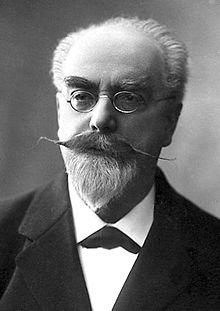Gabriel Lippmann
Jonas Ferdinand Gabriel Lippmann (born August 16, 1845 in Bonneweg (Bonnevoie), then Hollerich , Luxembourg ; † July 13, 1921 in the Atlantic on the France on the journey from New York to Le Havre) was a French physicist and Nobel Prize winner for physics .
Live and act
Gabriel Lippmann was the son of a Luxembourgish-Jewish family who moved to France soon after he was born, where he went to school. In 1883 Lippmann became a professor for mathematical physics and in 1886 for experimental physics at the Sorbonne .
Among other things, he developed the Lippmann method of color photography based on interference and named after him , which he presented to the Academy of Natural Sciences in 1891 and for which he received the Nobel Prize in Physics in 1908 .
The "reciprocal" or "inverse piezo effect ", which he theoretically founded in 1881, was experimentally proven by the brothers Jacques Curie and Pierre Curie .
Lippmann is considered one of the leading physicists of his time and was a member of many scientific organizations, including the Royal Society of London, the Royal Society of Edinburgh , the Prussian Academy of Sciences , the Russian Academy of Sciences and the Académie des Sciences in Paris.
Lippmann's work on color photography is largely forgotten today. Important from today's perspective, his work on electrocapillarity (English electrocapillarity ). He developed the capillary electrometer in 1872 . Along with his work on electrowetting (English electrowetting ) he laid important foundations for the field of microfluidics . With the help of this process, the smallest liquid droplets can be moved back and forth on surfaces. In addition to biotechnological microfluidic applications, displays (electronic paper) and lenses with an electrically switchable focal length can also be produced in this way .
Lippmann also invented a device ( Coelostat or Zölostat), an auxiliary instrument in practical astronomy, in order to track the daily rotation of the sky with fixed telescopes - especially tower telescopes (1893).
The Research Center Center de Recherche Public - Gabriel Lippmann in Beles (French: Belvaux), Luxembourg was named after Gabriel Lippmann . He is also the namesake for the Lippmann Islands off the west coast of Graham Land, Antarctica.
Individual evidence
- ↑ Official first names according to the birth certificate, reproduced by R. Stumper: Luxembourg scientists abroad . Verlag Letzeburger Land, Luxembourg 1962, p. 66
- ↑ Jos. A. Massard: Gabriel Lippmann et le Luxembourg . (PDF; 2.4 MB) In: JP Pier and JA Massard (eds.): Gabriel Lippmann: Commémoration par la section des sciences naturelles, physiques et mathématiques de l'Institut grand-ducal de Luxembourg du 150e anniversaire du savant né au Luxembourg, lauréat du prix Nobel en 1908. (PDF; 7.1 MB) Section des sciences naturelles, physiques et mathématiques de l'Institut grand-ducal de Luxembourg en collaboration avec le Séminaire de mathématique et le Séminaire d'histoire des sciences et de la médecine du center universitaire de Luxembourg, Luxembourg 1997, pp. 81–111.
- ↑ Gabriel Lippman, Scientist, Dies at Sea . In: The New York Times . July 14, 1921.
- ^ S. Katzir: The beginnings of piezoelectricity: A Study in Mundane Physics. Springer 2006, p. 35ff. See also: The piezo effect and its applications ( Memento from December 19, 2015 in the Internet Archive ) (PDF; 178 kB) by Hottinger Baldwin Messtechnik, Darmstadt.
- ↑ F. Mugele and JC Baret: electrowetting: from basics to applications . In: J. Phys .: Condens. Matter . Volume 17, 2005, No. 28, pp. R705-R744
Web links
- Information from the Nobel Foundation on the 1908 award ceremony to Gabriel Lippmann (English)
- Biography on the Nobel Prize website
- Entry to Lippmann; Gabriel Jonas (1845-1921) in the Archives of the Royal Society , London
- CV at the former Center de Recherche Public Gabriel Lippmann. Archived from the original on November 23, 2011 .
| personal data | |
|---|---|
| SURNAME | Lippmann, Gabriel |
| ALTERNATIVE NAMES | Lippmann, Jonas Ferdinand Gabriel (full name) |
| BRIEF DESCRIPTION | French physicist and Nobel laureate in physics |
| DATE OF BIRTH | August 16, 1845 |
| PLACE OF BIRTH | Bonneweg (Bonnevoie) |
| DATE OF DEATH | July 13, 1921 |
| Place of death | Atlantic |


